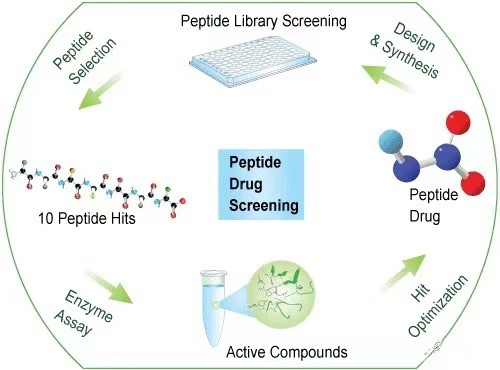Construction and screening of peptide libraries
1. Peptide library construction and screening
Peptide library concept:
Peptide library is a collection of a large number of small peptides of specific length and different sequences, which includes various (or most of the) amino acid sequences in the short peptide of this length. Some peptides, although their sequence is different from the natural epitope of the antigen, bind the antibody or ligand in the same way, so this peptide with a key amino acid residue is called a simulated epitope (mimotope). The concept of analog epitopes has played an important role in the development of peptide libraries. Peptide libraries provide powerful tools for drug design, protein-protein interactions, and other biochemical and pharmaceutical research and applications.
Peptide libraries are a powerful screening tool for biological and chemical research. It is used to screen a small number of peptides with key biological activities from a large number of peptides. Peptide libraries are widely used in proteomics and related fields, such as drug development, protein-protein interactions, epitope screening, GPCR ligand screening, protein function analysis, enzyme substrate or inhibitor screening, messenger molecule development, and peptide/protein signal response.

2. Types of peptide library
Overlapping Peptide Library: The overlapping peptide Library is used for full protein scanning. After the protein is extracted from the N terminal and gradually moved to the C terminal, an Orphan peptide is likely to be left in the end. It is recommended to transfer one or several amino acids from the N terminal to maintain a consistent length.
Truncation Peptide Library: Used to determine the minimum range of epitopes. Truncated peptide matrix is usually constructed by systematically removing amino acids on both sides of the original peptide sequence. The head peptide matrix was used to identify the least amino acid sequence associated with the activity.
Ala Screening Matrix (Alanine Peptide Scanning Library): Used to identify the influence of peptide sites on biological activity. Ala is systematically and sequentially substituted for each amino acid in the peptide sequence. Peptide libraries are screened by Ala to identify the effects of a particular amino acid on the structure, function and other biological activities of the entire protein.
Random Peptide Library: This peptide library is designed with 20 natural amino acids replacing selected amino acid residues simultaneously and randomly through the shotgun approach. Substitution peptides in such libraries may enhance the activity of peptides.
Scrambled Peptide Library: The design of this type of library is based on internal replacement of the amino acid sequence of the original peptide. It is the most mutated peptide library, and scrambled peptides are often used as negative controls to confirm that a particular sequence is key to protein function or activity. It's also a random screening tool for finding new targets.
Positional Scanning Peptide Library: Used for sequence modification to improve peptide activity. A selected region or site of a peptide is systematically replaced with other amino acids, and this class of peptide libraries helps researchers to discover a particular region with a particular effect or activity at a particular location.
3. Service Content:
(1) Custom peptide libraries based on known structures
Based on the structure of known compounds, a series of peptides are constructed and designed in the following ways, including but not limited to, and screened for the functions and indications of target compounds, in order to obtain new molecules or new structures with target efficacy.
N-terminal, C-terminal, side chain modifications: acylation, esterylation, PEG-ylation, beta-amino acid substitution, D-amino acid substitution, main chain aminomethylation, disulphide substitution, conformation locking (helical, beta-sheet), mirror peptides, cyclic peptides (end to end cyclization, side chain cyclization), special molecular labeling, hydroxyl acid substitution.
(2) Phage display peptide library
The genes encoding random peptide segments are synthesized artificially, and then the genes are cloned into the phage vector, and the peptides are displayed on the phage surface one by one by phage epitope display technology to construct a peptide library. During screening, peptides that bind to specific targets are screened from the library according to the specific interaction between specific receptor targets and some peptides in the peptide library.
(3) One plant one thing chemical combination peptide library
Combinational libraries are peptide libraries that can synthesize thousands of peptides at a time by randomly synthesizing peptides on resins. For example, a 5-peptide library would have 5 to the power of 5 pentapeptides, and a 9-peptide library would have 9 to the power of 9 nines. Then, according to the specific interaction between the specific receptor target and some peptides in the peptide library, the peptides that bind to the specific target are screened.
(4) DNA encoded chemical combination peptide library
Peptide libraries composed of thousands of peptides and DNA are synthesized randomly on the carrier resin, in which several nucleotides are synthesized for each amino acid to encode the information of the peptide. When screening, the receptor target needs to be attached to a fluorescent molecule, and if a peptide binds to the receptor, the corresponding resin will fluoresce. These fluorescing resins were then used as templates for PCR amplification, and then sequenced to obtain the peptide information.
---
More informations please click: Peptide library | Omizzur Biotech
Read Related Articles:
Copyright © 2020 Omizzur Inc | Terms & Conditions | Privacy Notice | Sitemap